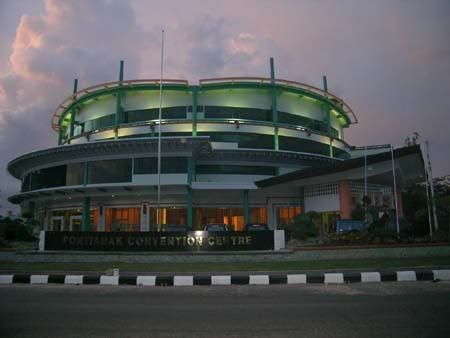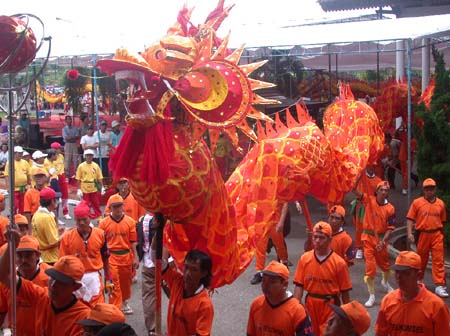The General Map of Pontianak City.


Pontianak, the lovely city is the water city.
History
PONTIANAK

BRIEF HISTORY
- The Pontianak Sultanate was founded in 1771 by a group of Arab adventurers led by al-Sayyid Sharif 'Abdu'l Rahman al-Kadri. This descendant of the Prophet had been drawn to Borneo by tales about diamonds and other riches. He made two impressive political marriages, to daughters of the Panembahan of Mampawa and Sultan of Banjar, respectively. Although they helped in creating a name for himself and to gain a foot hold on some territory, he failed to establish himself in effective power in Mampawa, Palembang or Banjarmarsin. Allying himself with the Dutch, he received recognition as Sultan of Pontianak in 1779. Although the Dutch made his son, by the Mampawa princess, Panembahan, he too failed to secure that throne.
'Abdu'l Rahman's successors maintained close relations with the British at Singapore, even after the return of the Indies to the Dutch. Several members of the family pursued commercial interests there, and it served as the usual bolt hole for any members of the family who fell foul of the Dutch. This was especially the case after the latter concluded firm contracts with the Sultan during the 1820's and then began to increase effective control.
The sultanate became a flourishing economic and centre during the early twentieth century, particularly after the discovery and exploitation of oil. This valuable commodity became increasingly important as the century progressed. These valuable oil deposits provided the prime motive for Japanese interest in the East Indies.
The Borneo states and their people, of all ranks, perhaps endured more hardship under the Japanese, than other parts of South East Asia. The ruling classes were not generally well disposed towards them, several members of the aristocracy helping the Dutch and allied forces in clandestine operations. This cost them dearly in 1944, when the Japanese publicly beheaded several Bornean rulers and their relatives. Sultan Muhammad, his heir apparent, and twenty-nine other members of the Pontianak Royal Family and senior their senior officials were amongst that number.
On their return to Borneo, the Dutch restored the sultanate to al-Sayyid Sharif 'Abdu'l Hamid II [Max], younger son of Sultan Muhammad. He had been brought up with a thoroughly European education, graduated from the Military Academy at Breda, served as an officer in the Dutch army and had a Dutch wife. He soon became something of 'a fly in the ointment' to the infant republic. He supported the Indonesian Federation in opposition to the Javanese republic, serving both as President of West Kalimantan and as a federal minister. It took the diplomatic and persuasive powers of his brother prince, the Sultan of Yogyakarta, to bring him over. After the amalgamation with the Indonesian Republic on Java in 1950, the republican authorities frequently subjected him to harassment and periods of detention. Thereafter, 'Sultan Max' spent much of his time in the Netherlands, his wife having taken their children there for safety. The adat council invited his son, known as Max-Nico al-Kadri, to take up the duties of Sultan, but he refused. He preferred to remain in the Netherlands, where he had remained for most of his life. The council of nobles then chose a cousin, al-Sayyid Sharif Ahmad Yan, the son of his father's eldest sister and younger brother to 'Abdu'l Hamid II's predecessor.
STYLES & TITLES:
The ruling prince: Sri Paduka Sultan al-Sayyid Sharif (personal name) ibnu al-Marhum (father's titles and name) al-Kadri, Sultan of Pontianak, with the style of His Highness.
The principal consort of the ruling Prince: Maha Ratu (personalised title suffix).
The Heir Apparent: Pangeran Adipati Anum Sri Maharaja.
The other male members of the dynasty, descended in the male line: al-Sayyid Sharif (personal name) ibnu al-Marhum (father's titles and name) al-Kadri.
The other female members of the dynasty, descended in the male line: Sharif a (personal name) ibnu al-Marhum (father's titles and name) al-Kadri.
NB: the senior male members of the Royal house usually also receive princely titles, on reaching their majority. These begin with the title of Pangeran, usually combined to an office, such as, Bendahara, Laksamana, etc.
1. Syarif Abdurrahman Alkadrie had ruled 1771 -1808.
2. Syarif Kasim Alkadrie had ruled 1808-1819.
3. Syarif Osman Alkadrie had ruled 1819-1855.
4. Syarif Hamid Alkadrie had ruled 1855-1872.
5. Syarif Yusuf Alkadrie had ruled 1872-1895.
6. Syarif Muhammad Alkadrie had ruled 1895-1944.
7. Syarif Thaha Alkadrie had ruled 1944-1945.
8. Syarif Hamid Alkadrie had ruled 1945-1950.
After the end of war, the Japanese officers in Pontianak were arrested by allied troops and brought in front of an international military tribune. During the trial, it was revealed that the plan to start the rebellion did not exist and instead was only an imaginary plan created by Japanese officers who wanted to get promoted.
The massacre occurred from April 23, 1943 to June 28, 1944 and most of the victims were buried in several giant wells in Mandor (88 km from Pontianak). Allied forces occupying the area after the war found several thousand bones, and more than 60 years after the massacre, several secret graves of the victims were found in Mandor and the surrounding areas. A monument called Makam Juang Mandor was created to commemorate this tragic event.





Masjid Jami' Pontianak is the oldest mosque in Pontianak that built by Sultan Syarief Abdurrahman Alkadrie which is 33.7 meters in length and 27.74 in width. It is a mosque with conical four-stacked roof that the top of the roof resemble a cown or giant bell. As the enormous influence of the Dutch architecture , both the roof of the Kadariah Palace and Masjid Jami mosque are the same.
There are six massive pillars and 14 supporting pillars sustaining the centre room of the mosque.It is intentionally built at 1.5 meters above the earth considering the location is near the Kapuas River. It is aimed to prevent from the rising water of Kapuas River. The Europian architechtural styles on the windows and the doors are clearly seen while the Middle East architechtures are on the mihrab ( chamber in mosque indicating the kiblah ). Above the mihrab , a green iron plate decorated by Arabic calligraphy stating that it was built by Sultan Syarief Abdurrahman Alkadrie on Tuesday , Muharram in 1237 Hijriyah.

Equatorial area in Pontianak.

The Adipura monument.

 Beting area in Pontianak.
Beting area in Pontianak.The floating houses of the Beting Permai complex at Kampung Dalam reminded us of the water village in Brunei’s Bandar Seri Begawan. A four-kilometre wooden walkway connects each house in the village.Kampung Dalam is the oldest part of Pontianak, where the Kadariah Palace, which was founded in 1771, and its Ja’mi mosque are located.





Kapuas River.

The Kapuas river, about 1,143 km, is the longest river in Indonesia, connecting Pontianak with the Sanggau, Sintang and Kapuas Hulu Regencies. Among the branches of the Kapuas river are the Landak, Kubu, Punggur, Melawi and Sekayam rivers.






Pontianak Waterfront, West Kalimantan.
Pontianak is an exotic land on Equator .




Kuching Waterfront

Pontianak-Kuching Friendship

Pontianak Convention Centre ( PCC )


Gajah Mada Street ( Flamboyan Traditional Market)

A Yani Megamall
Coordinates:
| Country | Indonesia |
|---|---|
| Province | West Kalimantan |
| Established | 23 October 1771 |
| Government | |
| - Mayor | Buchary Abdurrahman |
| Area | |
| - Total | 107.82 km² (41.6 sq mi) |
| Population (2004) | |
| - Total | 516,737 |
| Time zone | WIB (UTC+7) |
Motto: Pontianak the Equatorial City with the Vision to be an International Trade Center with Quality Service.
Education

Tanjungpura University, Pontianak
Demographics
Composition of Pontianak's population
| No. | Ethnic | Procentage (%) |
| 1. | Chinese | 31.24 |
| 2. | Malay | 26.05 |
| 3. | Bugises | 13.12 |
| 4. | Javanese | 11.67 |
| 5. | Maduranese | 6.35 |
| 6. | Others | 8.57 |
| TOTALT | 100 | |
Cultutal Event
There are several annual events in Pontianak.

Tari persembahan is a welcome dance of Malay's ethnic.
1. Meriam Karbit's Festival
Meriam Karbit (Carbide Cannon ) which is popularly known by locals during 'Hari Raya Idul Fitri' festival are being seen along the Kapuas river at Pontianak. It is a common tradition practiced from ancient Pontianak Sultan until today. Kampong Kemboje is a one of the favouriete places to see this festival. In Kampong Kemboje Meriam Karbit's Festifal is usually organized by GMKK ( Generasi Muda Kampong Kemboje ), Association Of Young Generation of Kemboje's Village .


Meriam Karbit ( Carbide Cannon )
2. Cap Go Mei
The Chinese celebration of Cap Go Meh (Lantern Festival) at the end of the 15-day Lunar New Year festivities, the Chinese community perform a street parade of dragon and lion dances, with the Malays and Dayaks performing their own cultural dances.

Barongsai ( The Lion Dance )

The Dragon Show.
3. Gawai Dayak
Gawai Dayak is a festival of Dayak's ethnic . It is usual hold from may,20th- may,25th at The Rumah Panjang ( The traditional House of Dayak's ) , Jl. Sutoyo .

Dayak's Dance.
Places of interest
The equatorial line is marked by the Equator monument, which marks the division between the northern and southern hemispheres.
Shopping malls available include Mal Matahari, Mal Gajahmada, Mal Ramayana Pontianak, Megamal A Yani.
Restaurants available include KFC fast food chain with 3 outlets, Pizza Hut at Mal Gajahmada, Texas Fried Chicken, California Fried Chicken, American Restaurant next to Hotel Gajahmada and 200 metres from Hotel Santika, Italian Steak House & Hawaii Restaurant across the street from Hotel Kini, Sari Bento Japanese and Indonesian food & Gajahmada Restaurant at Teuku Umar Shop House Complex, and Istana Buah Restaurant at Jalan Gajahmada.
Pontianak's Food is like no other in the world. For an authentic taste of Pontianak's food, the place not to be missed is the food district surrounding the "Sudirman" market. Note the operating hours of dusk to 9-ish PM. Other places to check out are those along the Gajahmada road, Tanjungpura road, Pahlawan road, and Diponegoro road. The food stalls are open-air settings, and serve many authetic ethnic Chinese food. The Pontianak Chinese cuisine is unlike any Chinese food you would find in China, Thailand, Singapore, or any other Overseas Chinese outpost. The Chinese in Pontianak are, culinary-wise, well integrated, and they have introduced an indellible tropical and spicy accent to their simple Teochew and Hakka cuisine.
Supermarkets and Departemental Stores include Matahari (Mal Matahari), Matahari , Hyper Mart and a lot of shops in A Yani Mega Mall ( Biggest Mall in Pontianak ), Ramayana (Mal Ramayana), Ligo Mitra, Kaisar, Harum Manis, Mitra Anda, Garuda Mitra and Mitra Mart.

 |
References :
http://www.pontianak.go.id
http://pontianak-tourism.blogspot.com
http://bogantropuz.deviantart.com
http://www.4dw.net/royalark/Indonesia/pontian.htmhttp://article.melayuonline.com





Tidak ada komentar:
Posting Komentar